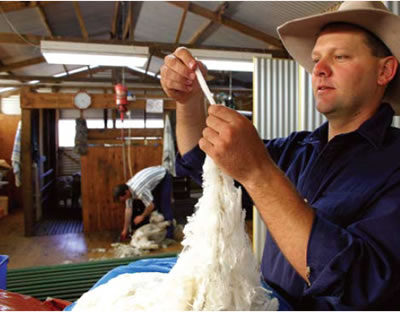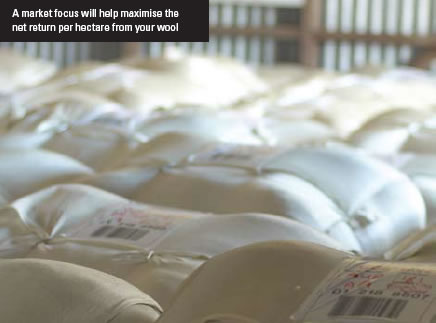 |
 |
Use AWEX, your wool broker and/or Woolcheque to estimate the value of your wool
|
 |
Use your wool value estimates to set auction reserve prices or negotiate direct sales
|
 |
Consider wool selling options 4–6 months ahead of shearing and evaluate a range of methods
|
 |
Develop strategies to manage price unpredictability before shearing and keep under regular review. |
|
 |
Introduction
Wool producers have many selling options available to them. The options will vary according to the scale of your enterprise, and the characteristics of the wool you produce (micron, market speciality). To secure the true market value of your wool, work with your wool broker or adviser when using any of these selling options. The more commonly used methods include:
- Open-cry ‘progressive’ auction – The preferred method of sale and ownership transfer for about 85% of wool producers. This system is facilitated and managed by wool brokers, guarantees payment, and allows maximum exposure and competition for wool at sale time, with all major buyers of Australian wool present in the auction rooms.
- Private treaty – Prices are negotiated privately with buyers at or about the time of shearing. Wool may be sold either tested or untested, however, untested wools will not be paid the same as tested wools.
- Forward sales – A contract is made before shearing to deliver wool to an agreed specification and to an agreed price schedule. Payment is made against the actual test results. Remember that once contracted, your wool must meet specifications.
- Direct to topmaker/exporter – Similar to forward contract, but a spot sale through an exporter for delivery direct to a topmaker. Negotiation of the final price in Australian currency must be managed carefully to eliminate fluctuations in currency exchange rates.
- Internet selling – Electronic offer board where wool is available for sale to buyers 24 hours a day, 7 days a week. A reserve price is ‘posted’ (presented for sale on computer screen) and can be simultaneously seen by all registered buyers. Submission of bids and final sale is facilitated via the offer board, and not directly with the seller. The most significant advantage of an electronic offer board comes in a rising market, when it allows buyers to purchase wool lots outside the scheduled auctions. See the link to Wooltrade in the signposts.
- Grower marketing groups – Grower based marketing groups established to sell direct to processors and manufacturers. Grower marketing groups need a structure, training and a sound business case to succeed and be profitable over time.
- Wool Pools – A contract is made to deliver a volume of a shearing or yearly production to the pool up to 12 months prior to shearing. By participating in the pool you are assigning the risk management of you wool portfolio to a third party. The aim is to reduce exposure to price volatility. An upfront payment occurs after delivery based on a percentage of the current market. At the close of the pool a final payment is made based on the performance of the pool against the physical market. This option also includes traceability, downstream education and opportunities for contact with end use customers. See the link to TMC pools in the signposts.
- Grid Sales Similar to selling livestock “over the hooks”, prices are offered from a set grid of prices for wool delivered to store. Prices are generated from all stages of the demand chain as the various businesses feed direct orders from the pipeline. Most wool selling brokers will offer some form of grid sales or a price at door pricing system for their clients.
- Partnership Processing – retained ownership Some processors offer an option to growers allowing the grower to retain ownership of the wool beyond the greasy form. By using downstream manufacturers infrastructure, a grower can participate in the value add of wool from top to yarn to garment. This partnership results in a sharing of the profit as wool is transformed into retail products. See the link to Michell Direct in the signposts.
- Chain pipeline sales – Wool4 The Wool4 program is an example of a commercial value chain pipeline to provide an ethical and sustainable product to the global textile market. The aim is to give growers a means of differentiating their wool based on complying with set production standards. See the link to the Landmark Wool4 program in the Signposts.
- Mill Direct Marketing wool through Mill Direct enables an offer of growers wool directly to a network of international processors at your own set price. It provides the opportunity to receive valuable feedback on your product and build strong relationships for future orders. See the link to Elders Mill Direct in the signposts
Key decisions, critical actions and benchmarks
If immediate sale prospects are poor at the time of shearing and the outlook is for improving price, consider holding wool in store pending a later sale (defer selling). Alternatively, sell part of the clip (split selling) and defer the remainder to a time of lower supply. Work closely with your wool broker or adviser and be aware of storage costs and the time value of money.

Valuing your wool
You can use the web-based tool, Woolcheque, to independently value your wool clip with the prices sourced from the historical AWEX market reporting system.
Woolcheque can be used for:
- Modeling different clip scenarios and flock management strategies
- Daily and historical valuation of clip details
- Understanding the role that premiums and discounts for staple strength, VM, staple length etc play in achieving profitability
- Appreciating the importance of price risk management.
Woolcheque includes up-to-date market pricing, useful price charts and lot benchmarking, (see signposts).
Alternatively, you can use your wool brokers’ appraisals. These appraisals may differ from those provided by Woolcheque. Brokers’ appraisals incorporate a visual inspection of your wool in the sample box, anticipated market movements and the quantity of offerings in the forward weeks to provide an estimate of what your wool will achieve at auction. Woolcheque values your wool based on previous auction results only. It is prudent to use both the Woolcheque valuation and your broker’s appraisal when marketing your wool.
Selling options
Plan your selling system 4–6 months before shearing commences. The final choice will be determined by a number of factors including:
- Short- to medium-term market outlook and projected price trends
- Estimates of the value of your wool using information from broker valuations, forward markets or Woolcheque
- Prices on offer relative to that valuation and expected price trends
- Estimates of selling and possible storage costs
- Your own financial circumstances, including the cost of production
- Potential risks of market volatility and your approach to managing price risks.
It is recommended that you monitor market conditions and review approaches to selling, up to the point of sale.
Managing price volatility
The profitability of your enterprise is determined by a combination of seasonal conditions, your personal management programs, and wool price cycles. Wool prices, like all commodity prices, move in cycles, as shown in figure 2.1 below:

Figure 2.1 - Commodity price cycles in key wool markets over 15 years (Source: The Woolmark Company)
A recent study indicated that wool price volatility is the major source of business risk on woolgrowing farms. Wool price volatility contributed about 80% of the variability of return on equity, while production risk contributed about 20% of the variability. Yet few wool producers have appropriate strategies in place to reduce the risk of low and unprofitable wool prices.
Price risk management programs and products can help protect your profitability from volatile commodity prices and the vagaries of the weather.
Wool brokers and advisers can access a wide variety of price risk management tools around the world to help reduce the uncertainty of future cash flows. It is important to seek professional advice to understand the practicalities and implications when developing strategies to manage price risk. Options include:
-
Making use of forward selling or hedging options such as selling wool futures before shearing.
-
Accessing price risk management tools through a wool agent or exporter. This eliminates most of the risk of price fluctuation, but production and wool quality risk remains.
-
Exploring fixed price wool indicator contracts, wool minimum price facility, and deferred price contracts.
Some on-farm approaches to managing the current market situation and possibility of price volatility at the time of sale include:
- Spreading the risk by offering your clip over more than one scheduled sale
- Setting well researched and realistic reserves to protect against downside risk of price fluctuations and maintain flexibility up to the time of sale.
Holding wool in storage requires an assessment of the likely storage costs and financial impact of a delay in wool sales against the potential for price gains when wool is finally sold.
Signposts  |
Read
A Marketing Guide for Wool Growers: a
manual that outlines the various methods
and operations involved in selling
wool. To order, call the AWI Helpline
1800 070 099 (free within Australia).
Risk Management for Woolgrowers:
explains alternative approaches to risk
management. To order, call the AWI
Helpline 1800 070 099 (free within
Australia
AuctionsPlus Wool: an internet based wool
selling and trading system allowing
wool producers to offer their clips to all
buyers 24 hours/7 days per week: https://wool.auctionsplus.com.au/
Woolcheque: the wool pricing tool
for Australian wool producers: https://www.wool.com/market-intelligence/woolcheque/
Risk management products: visit http://riemann.com.au/products/. For further information on Risk Management see: www.wool.com/about-awi/media-resources/news/tools-being-developed-for-price-risk-management/
Independent Commodity risk
management For an independent
source of managing your price risk on
wool return. Search the internet for
specialist providers such as Market Check
and AgConcepts Unlimited.
Websites for managing wool price risk
and market volatility can be found at:
For futures, bank products, grid sales
and forward selling options all wool
selling brokers sites have service facilities
available and a licensed to trade advisor.
Contact your broker for service and
advice for your best option.
For independent market information and advice visit: http://www.mecardo.com.au/
Mill direct supply serviced by Elders in
conjunction with their export arm Elders
Wool International can be viewed at https://eldersrural.com.au/wool/selling-options/
Grower marketing groups
Contact your local wool broker and
arrange for a licensed futures adviser to
contact you.
|
|